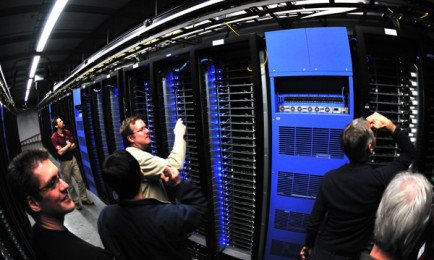On the Internet, every 60 seconds is jam-packed with activity – Google receives more than 4 million searches queries, YouTube users upload 72 hours of footage, 204 million emails are sent, Facebook users share about 2.46 million pieces of content and Apple users download 48,000 apps.
“The number of social interactions we have with Twitter, Flickr and all of those applications are skyrocketing – but those are only the smaller transactions,” said Mary Whatman, founder of Parhelion (a strategic advising firm for the communications and mobility industries), in a panel discussion at the Datacentres Europe Congress in Monaco last week.
(Disclosure: tech.eu was part of a group of journalists invited to attend Datacentres Europe 2014.)
“We, as individuals are generating vast amounts of data and it’s only getting started,” added Whatman.
For many people, using the Internet has become so ingrained in our fast-paced lives that we scarcely take the time to think: Where does the data come from? How much are we creating? Where does it go?
The key topic during this particular panel discussion circled around the exponential increase of data growth and how it’s fundamentally affecting traditional business and society – particularly, the storage, access, aggregation and analysis of this data.
Whether we’re conscious of it or not, each of us are contributing to the avalanche of digital activity circulating through cables and networks.
Everything from your music selection on Spotify to your purchases on Amazon to the location signals emitted from your mobile phone leave a digital trail. Even if the data seems invisible and impersonal, it’s most definitely there and taking up space – namely, physical space in a data center.
"A single data center can take more power than a medium-size town"
In 2012, the amount of data created reached 2.8 zettabytes – this number is slated to double again by 2015, according to market research firm International Data Corporation.
Not familiar with a “zettabyte”? It’s equivalent to 1 000 000 000 000 000 000 000 bytes, which is an amount as huge as it looks.
Despite the fact that data centers play a large role in supporting our digital lives and underpin the business of many tech empires – such as Google, Microsoft and Facebook – for a long time the operation of these massive computing centers were mostly concealed from end users.

In 2012, The New York Times debuted a four-part investigative piece in an effort to shed light on how data centers around the world were impacting the environment as the amount of digital information continued to grow at a stupendous rate.
The report estimated that digital warehouses worldwide consumed approximately 30 billion watts of electricity, which was “roughly the equivalent to the output of 30 nuclear plants”.
Additionally, in the NYT piece, Peter Gross, who worked on the design of hundreds of data centers, offered a startling insight: “A single data center can take more power than a medium-size town.”
Following the NYT’s publication of the series, a flurry of responses inundated the web.
Some lauded the Times for taking on the investigation despite the oft-reported secrecy in this realm, while many in the industry disputed the report’s over-simplification, unfair portrayal of data centers as well as inclusion of outdated anecdotes (many from 2006).
Although there are some key omissions from the NYT's sweeping report – namely, the industry's acknowledgment and efforts to reduce its energy inefficiencies – the series was a good way to raise consciousness about data centers to the general public as well as make tech giants more conscientious about their activities.
Pushing for change
“Social networks and mobility in computing – in the way that we’re accessing data – has changed, and is changing, very very rapidly,” said Chris Scott, a service area executive from IBM Global Technology Services Europe, in a talk about how smarter data centers can enable business change and innovation.
IBM just announced the opening of a new SoftLayer data center in Hong Kong, the first of 15 centers planned as part of a $1.2 billion investment to strengthen and expand the company's cloud services in Asia and around the world.
With the explosion of digital information, the number of data centers spotting the globe will only continue to grow.
Things seem to be a-changin' in this space in regards to improving energy efficiency – Google recently announced the use of artificial intelligence to improve data center efficiency and Facebook is taking an Ikea approach to shipping its equipment to its new Swedish data center.
Although these massive computing centres may seem like elusive creatures to the public, they are undoubtedly impacting the infrastructure of our cities and environment. And the industry knows it, too, which is why there are numerous data center conferences, similar to the Datacenter Europe Congress, held across the globe each year.
Typically, these events bring together data center professionals (mostly middle-aged white men clad in suits) to discuss power usage effectiveness (also known as PUE, a popular term in this sphere) and the future of renewables in the data centre, among other things.
Though concern over the efficiency of data isn't new, the role of the Internet is undoubtedly growing in our lives – affecting everything from healthcare to transportation systems – and it's crucial to continue reminding ourselves of its impact on the environment.
With the free and frictionless ease of surfing the web, ultimately, it's about not taking for granted how the infrastructure works and constantly questioning whether our actions, alongside those of the Internet juggernauts, are "reasonable or reckless".
Data: Just because you don't see it (often), doesn't mean it's not there.
Featured image credit: Oleksly Mark / Shutterstock Facebook data center image credit: Courtey of Flickr user Intel Free Press


